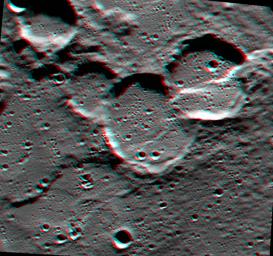
|
Cuts Right Through
- Click the image above for a larger view
- Full-Res JPEG (925 x 867) (169.5 kB)
- Full-Res TIFF (925 x 867) (2.4 MB)
Caption:
Today's image is located on the western edge of the Rembrandt basin . A scarp cuts right through a pair of older impact craters, leaving them deformed. This image is an anaglyph, which creates a 3D effect when viewed through a pair of red-cyan glass . If you've found a pair of glasses, check out these other 3D views created with MESSENGER images.
This image was acquired as a targeted set of stereo images. Targeted stereo observations are acquired at resolutions much higher than that of the 200-meter/pixel stereo base map. These targets acquired with the NAC enable the detailed topography of Mercury's surface to be determined for a local area of interest.
Date acquired:
August 13, 2013
Image Mission Elapsed Time (MET):
18733660, 18734492
Image ID:
4625953, 4625956
Instrument:
Narrow Angle Camera (NAC) of the Mercury Dual Imaging System (MDIS)
Center Latitude:
-37.6°
Center Longitude:
79.15° E
Resolution:
100 meters/pixel
Scale:
This image is roughly 90 kilometers across (56 miles)
Incidence Angle:
81.0°, 81.0°
Emission Angle:
0.3°, 19.9°
Phase Angle:
81.2°, 81.9°
Orientation:
North is to the right to enhance the 3D effect
Background Info:
The MESSENGER spacecraft is the first ever to orbit the planet Mercury, and the spacecraft's seven scientific instruments and radio science investigation are unraveling the history and evolution of the Solar System's innermost planet. MESSENGER acquired over 150,000 images and extensive other data sets. MESSENGER is capable of continuing orbital operations until early 2015.
For information regarding the use of images, see the MESSENGER image use policy .
Cataloging Keywords:
| Name | Value | Additional Values |
|---|---|---|
| Target | Mercury | |
| System | ||
| Target Type | Planet | |
| Mission | MESSENGER | |
| Instrument Host | MESSENGER | |
| Host Type | Orbiter | |
| Instrument | Mercury Dual Imaging System (MDIS) | |
| Detector | Narrow Angle Camera (NAC) | |
| Extra Keywords | Color, Crater, Impact, Map, Radio | |
| Acquisition Date | ||
| Release Date | 2014-04-29 | |
| Date in Caption | 2013-08-13 | |
| Image Credit | NASA/Johns Hopkins University Applied Physics Laboratory/Carnegie Institution of Washington | |
| Source | photojournal.jpl.nasa.gov/catalog/PIA18231 | |
| Identifier | PIA18231 | |
